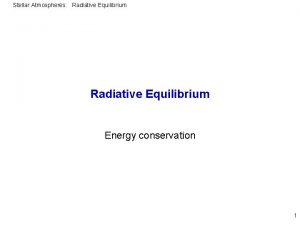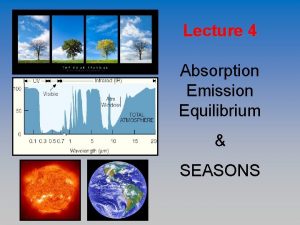Validation of the 6 S Radiative Transfer Code

- Slides: 1

Validation of the 6 S Radiative Transfer Code for Atmospheric Correction of MODIS data Svetlana Y. Kotchenova (skotchen@kratmos. gsfc. nasa. gov) & Eric F. Vermote (eric@kratmos. gsfc. nasa. gov) Purely Molecular Atmosphere Radiative Transfer Codes 6 S (no polarization) - Second Simulation of the Satellite Signal in the Solar Spectrum n o A polarized electromagnetic wave is described by a set of 4 Stokes’ parameters, which are related to the amplitudes of the components ( and ) of the electric field: If an electromagnetic wave is not polarized, then p o l a r i z a t i o n This code is based on the method of successive orders of scattering approximations. It enables accurate simulations of satellite and plane observations, accounting for elevated targets, use of anisotropic and Lambertian surfaces, and calculation of gaseous absorption. s c a l a r c o d e s References – (1) The 6 S User Guide; (2) Vermote et al. , IEEE T. Geosci. Remote, 35(3), pp. 675 -686, 1997. Availability – by request from E. Vermote This code is designed to compute monochromatic radiance / fluxes in the shortwave spectral region over Lambertian and anisotropic surfaces. The atmospheric properties can be changed arbitrarily in the vertical dimension. The code is based on the modified method of spherical harmonics. References – (1) Manual: Code SHARM-1 D; (2) Muldashev et al. , J. Quant. Spectrosc. Radiat. Transfer, 61(3), pp. 393 -404. 1999. Availability – by request from A. Lyapustin, NASA GSFC. Availability – by request from E. Vermote, UMd Some results of the comparison are presented on the right. Both codes calculated the reflectance at the top of the atmosphere as an output parameter. The relative difference was calculated using SHARM as a reference. where θ is the scattering angle Results direction of incident light Accurate modeling of molecular scattering is especially important for satellite monitoring of ocean color and the inversion of aerosols over land, which require measurements in the blue spectral range. • The maximum relative difference between the outputs of 6 S (no polarization) and SHARM does not exceed 0. 3%. In general, the absolute difference between the codes slightly increases with the increase of VZA or optical thickness. The use of ρ = 0. 25 leads to a decrease of the maximum difference to 0. 2%. • The models difference is not of concern, as it is more than 6 times less than the 2% accuracy of raw MODIS top-ofatmosphere reflectance data Purely Aerosol Atmosphere Comparison between 6 S (no polarization) and SHARM purely aerosol atmosphere, 70% of dust + 30% of water-soluble particles, optical thickness = 0. 72804, SZA = {0. 0; 11. 48; 23. 07; 32. 86; 58. 67}, AZ = {0; 90. 0; 180. 0} Mie scattering larger particles This type of scattering predominates for particle sizes larger than the wavelength λ. It is characterized by an asymmetric phase function P(θ), which produces a scattering pattern direction of incident light similar to an antenna lobe, with a sharper and more intense forward lobe for larger particles. This scattering is not strongly λ-dependent – the reason of the appearance of almost white glare around the sun when a lot of particular (e. g. dust, soot) material is present in the air. Monte Carlo (with polarization) In this computation one photon at a time is followed on its threedimensional path through the atmosphere. The various events which may happen to the photon at various heights are defined by suitable probability distributions. This code is considered a ‘benchmark’ for any other RT code, as it does not have any limitations except for large amounts of calculation time and angular space discretization. Comparison study 6 S (no polarization) has been tested against SHARM at λ = 0. 694 μm for a wide range of geometrical combinations of SZA, VZA and AZ. The selected aerosol model was similar to the standard continental model: 70% of dust + 30% of water-soluble particles. The aerosol phase function was calculated as in SHARM. Two values Aerosol model parameters of optical thickness, 0. 072804 and 0. 72804, were (phase function, single scattering albedo (SSA) and chosen to simulate ‘clear’ and ‘hazy’ atmospheric asymmetry factor (g)) conditions. Reference – F. -M. Bréon, J. Atmos. Sci. , 49, pp. 1221 -1232, 1992. Availability – by request from F. -M. Bréon, CEA/DSM/LSCE Gif sur Yvette, France. • Validation of the new version of 6 S which accounts for light polarization against Monte Carlo (with polarization) and K. L. Coulson’s • 6 S (no polarization) has been tested against SHARM for several different wavelengths over a wide range of geometrical combinations of view (VZA) and solar (SZA) zenith angles and relative azimuths (AZ). The selected values of atmospheric optical thickness included 0. 1 (λ ≈ 0. 53 μm), 0. 3445 (λ = 0. 4 μm), 0. 5 (λ ≈ 0. 36 μm). The ground surface was assumed to be Lambertian with reflectance ρ = 0 (black soil) and ρ = 0. 25. It is one of the most heavily tested codes available for plane-parallel atmospheric models. The simulated physical properties include thermal emission, scattering, gaseous absorption, and bidirectional reflection and emission at the lower boundary. The code is based on the discrete ordinate method for radiative transfer. Objectives • is the scattering from molecules. The intensity of scattered light is proportional to the (– 4) degree of the incident waveform λ – the main reason why the cloudless sky is blue. This type of scattering is characterized by a symmetric phase function: DISORT – ‘Discrete Ordinates’ polarization 6 S (with polarization) Comparison study SHARM-1 D Reference – (1) The DISORT Manual; (2) Stamnes et al. , Appl. Optics, 27(12), pp. 2502 -2509, 1988. Availability – ftp: //climate 1. gsfc. nasa. gov/users/ftp/wiscombe vectorial codes Rayleigh scattering tabulated values (Coulson et al. , ‘Tables Related to Radiation. . . ’, 1960) for a purely molecular atmosphere. Testing of the new version of 6 S in the scalar mode. Comparison with SHARM and DISORT for purely molecular and aerosol atmospheres under different atmospheric and surface boundary conditions. Demonstration of the importance of the effects of polarization 6 S (no polarization) and SHARM have also been compared with DISORT to make sure of a correct use of SHARM. Results SSA = 0. 9398 g = 0. 6969 Some results of the comparison are presented on the right. In comparison between SHARM and 6 S, SHARM was used as a reference. In other cases, DISORT was the reference. • The maximum relative difference between reflectances calculated by 6 S (no polarization) and SHARM does not exceed 0. 35%. As in the case of the purely molecular atmosphere, the absolute difference between the codes slightly varies in dependence of VZA and optical thickness. • DISORT and SHARM demonstrate better agreement with the maximum difference within 0. 1%, which can be explained by the equivalency of the methods for the azimuthally independent component. • Again, the models difference is negligible compared to the 2% accuracy of raw MODIS top-of-atmosphere reflectance data Effects of polarization Experimental applications of the new version of 6 S (with polarization) Comparison study Biomass burning smoke Ocean surface reflectance Surface reflectances calculated with the scalar (no polarization) and the vectorial (with polarization) versions of 6 S have been compared for a ‘biomass burning smoke’ aerosol model to study the effects of polarization for an aerosol atmosphere. The selected aerosol model is a typical pattern produced by forest fires over the Amazonian tropical forest region in Brazil (O. Dubovik et al. , J. Atmos. Sci. , 59, pp. 590 -608, 1996). The comparison was made for λ = 0. 67 μm. The results of the comparison showed that the relative difference between the atmospheric reflectances, 6 S (with polarization) vs. 6 S (no polarization) calculated with and without account for light polarization, can be biomass burning aerosol model, optical thickness = 0. 72804, as large as 5%. MODIS AQUA data, collected over the Hawaii islands, have been corrected using the new version of the 6 S code (with polarization) and AERONET measurements collected at Lanai island. The graph below shows the results of the comparison of surface reflectances measured by MOBY (the Marine Optical Buoy System) just above the ocean surface with AQUA estimated reflectances at λ={412; 443; 490; 530; 550; 667; 678} nm. The MOBY measurements were conducted during the year of 2003 on January 2, February 10, September 3, September 19, October 6, October 22. SZA = {0. 0; 11. 48; 23. 07; 32. 86; 58. 67}, AZ = {0; 90. 0; 180. 0} Average aerosol volume size distribution AQUA relfectances (from AERONET measurements) d. V/dlnr, (μm 3/μm 2) 6 S (with polarization) and SHARM have been tested against Coulson’s tabulated values (which, according to S. Chandrasekhar, represent the complete solution for the Rayleigh problem) for the case of a purely molecular atmosphere with optical thickness of 0. 1 and 0. 5, for a wide range of geometrical conditions. 6 S (with polarization) has also been tested against Monte Carlo for a purely molecular atmosphere with optical thickness of 0. 35 (λ = 0. 4 μm), for SZA = {0. 0, 23. 0, 57. 0} SSA = 0. 9237 g = 0. 585 MOBY * measured reflectances The agreement between the corrected AQUA and the MOBY surface reflectances was 0. 001 to 0. 002 for the 400 -550 nm region. radius, μm How to account for light polarization? Conclusions To make a scalar code account for polarization, one needs 1. Ignorance of the effects of light polarization leads to large errors in calculated top-of-atmosphere reflectances. The maximum relative error is more than 10% for a purely molecular atmosphere and is up to 5% for a purely aerosol atmosphere. • • • to modify the molecular phase function to account for dipole moments of molecules; easy to add new components to the aerosol scattering phase function to describe the polarization state of scattered light. relatively easy It means the replacement of ‘the MIE subroutine’. to add 3 new components ( ) describing polarization to the radiative transfer part of the code. It means the replacement not easy at all of the radiative transfer part (or the core) of the code. 2. The new vectorial version of 6 S, which accounts for polarization, has demonstrated good agreement with Monte Carlo and Coulson’s tabulated values for a wide range of geometrical and atmospheric conditions. The agreement is better than 0. 5% for Monte Carlo and 0. 3% for Coulson’s. 3. The new vectorial version of 6 S, used in the scalar mode, has demonstrated good agreement with the scalar code SHARM: better than 0. 3% for a purely molecular atmosphere and better than 0. 35% for a purely aerosol atmosphere. 4. Account for light polarization is extremely important for atmospheric correction of remotely sensed data, especially those measured over dark targets, such as ocean surface or dark dense vegetation canopies. We would like to thank F. -M. Bréon for providing the Monte Carlo code and A. Lyapustin for providing the SHARM-1 D code. We would also like to thank both of them for helpful discussions and suggestions during this study. This work was supported by NASA contract NNG 04 HZ 17 C.

